BUICK TERRAZA 2007 Owners Manual
Manufacturer: BUICK, Model Year: 2007, Model line: TERRAZA, Model: BUICK TERRAZA 2007Pages: 562, PDF Size: 2.96 MB
Page 91 of 562
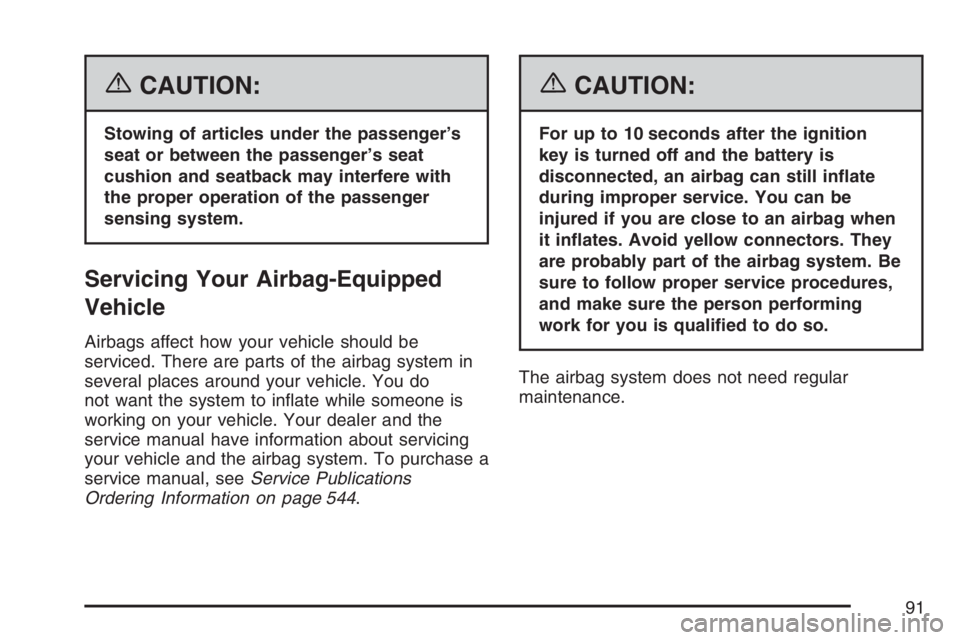
{CAUTION:
Stowing of articles under the passenger’s
seat or between the passenger’s seat
cushion and seatback may interfere with
the proper operation of the passenger
sensing system.
Servicing Your Airbag-Equipped
Vehicle
Airbags affect how your vehicle should be
serviced. There are parts of the airbag system in
several places around your vehicle. You do
not want the system to in�ate while someone is
working on your vehicle. Your dealer and the
service manual have information about servicing
your vehicle and the airbag system. To purchase a
service manual, seeService Publications
Ordering Information on page 544.
{CAUTION:
For up to 10 seconds after the ignition
key is turned off and the battery is
disconnected, an airbag can still in�ate
during improper service. You can be
injured if you are close to an airbag when
it in�ates. Avoid yellow connectors. They
are probably part of the airbag system. Be
sure to follow proper service procedures,
and make sure the person performing
work for you is quali�ed to do so.
The airbag system does not need regular
maintenance.
91
Page 92 of 562

Adding Equipment to Your
Airbag-Equipped Vehicle
Q:Is there anything I might add to the front
or sides of the vehicle that could keep the
airbags from working properly?
A:Yes. If you add things that change your
vehicle’s frame, bumper system, height,
front end or side sheet metal, they may keep
the airbag system from working properly.
Also, the airbag system may not work properly
if you relocate any of the airbag sensors. If
you have any questions about this, you should
contact Customer Assistance before you
modify your vehicle. The phone numbers and
addresses for Customer Assistance are in
Step Two of the Customer Satisfaction
Procedure in this manual. SeeCustomer
Satisfaction Procedure on page 526.
Q:Because I have a disability, I have to get
my vehicle modi�ed. How can I �nd out
whether this will affect my airbag system?
A:Changing or moving any parts of the
front seats, safety belts, the airbag sensing
and diagnostic module, steering wheel,
the instrument panel, or airbag wiring can
affect the operation of the airbag system. If
you have questions, call Customer Assistance.
The phone numbers and addresses for
Customer Assistance are in Step Two of the
Customer Satisfaction Procedure in this
manual. SeeCustomer Satisfaction Procedure
on page 526.
92
Page 93 of 562
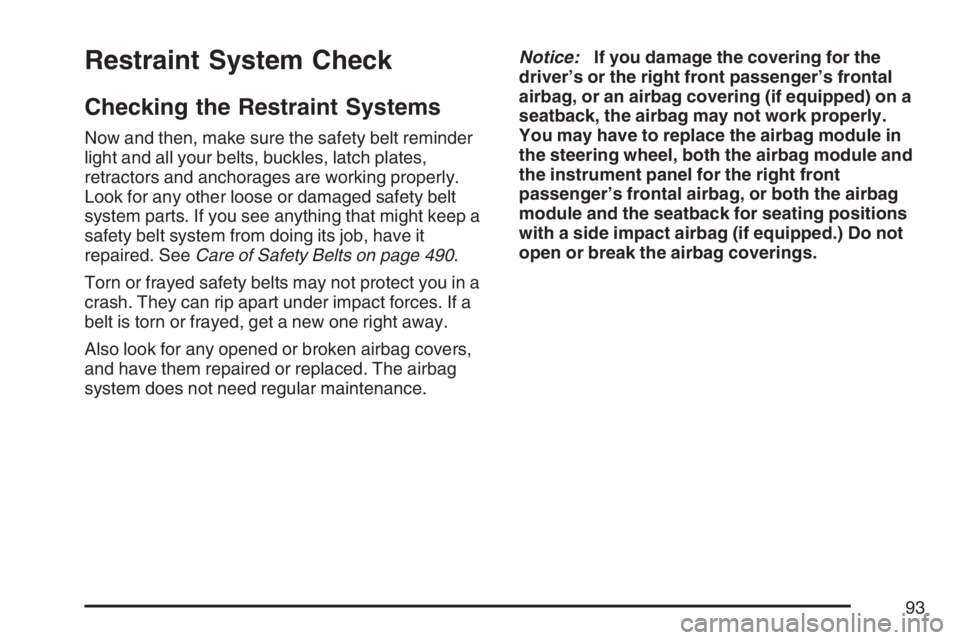
Restraint System Check
Checking the Restraint Systems
Now and then, make sure the safety belt reminder
light and all your belts, buckles, latch plates,
retractors and anchorages are working properly.
Look for any other loose or damaged safety belt
system parts. If you see anything that might keep a
safety belt system from doing its job, have it
repaired. SeeCare of Safety Belts on page 490.
Torn or frayed safety belts may not protect you in a
crash. They can rip apart under impact forces. If a
belt is torn or frayed, get a new one right away.
Also look for any opened or broken airbag covers,
and have them repaired or replaced. The airbag
system does not need regular maintenance.Notice:If you damage the covering for the
driver’s or the right front passenger’s frontal
airbag, or an airbag covering (if equipped) on a
seatback, the airbag may not work properly.
You may have to replace the airbag module in
the steering wheel, both the airbag module and
the instrument panel for the right front
passenger’s frontal airbag, or both the airbag
module and the seatback for seating positions
with a side impact airbag (if equipped.) Do not
open or break the airbag coverings.
93
Page 94 of 562
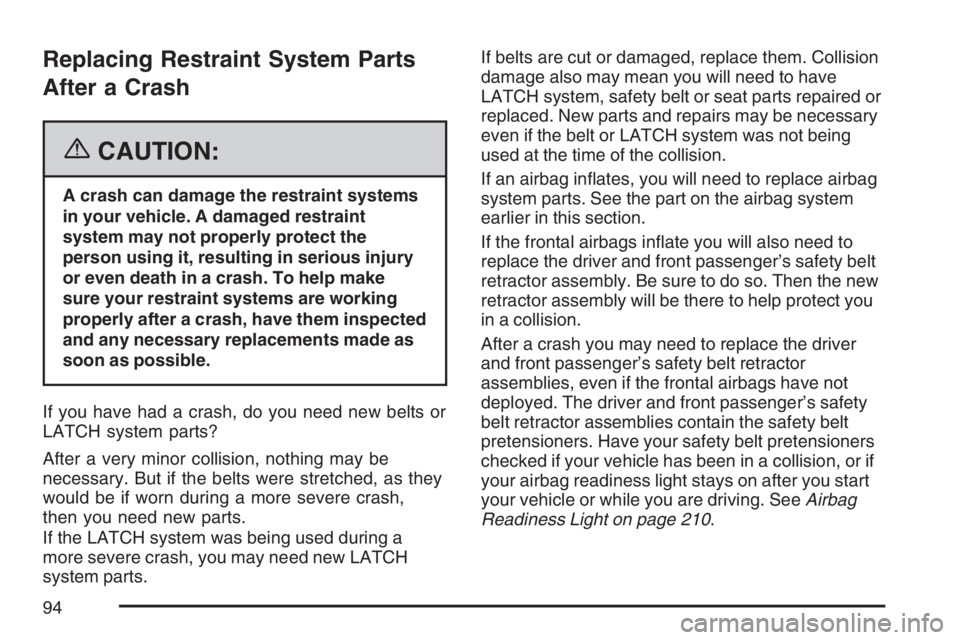
Replacing Restraint System Parts
After a Crash
{CAUTION:
A crash can damage the restraint systems
in your vehicle. A damaged restraint
system may not properly protect the
person using it, resulting in serious injury
or even death in a crash. To help make
sure your restraint systems are working
properly after a crash, have them inspected
and any necessary replacements made as
soon as possible.
If you have had a crash, do you need new belts or
LATCH system parts?
After a very minor collision, nothing may be
necessary. But if the belts were stretched, as they
would be if worn during a more severe crash,
then you need new parts.
If the LATCH system was being used during a
more severe crash, you may need new LATCH
system parts.If belts are cut or damaged, replace them. Collision
damage also may mean you will need to have
LATCH system, safety belt or seat parts repaired or
replaced. New parts and repairs may be necessary
even if the belt or LATCH system was not being
used at the time of the collision.
If an airbag in�ates, you will need to replace airbag
system parts. See the part on the airbag system
earlier in this section.
If the frontal airbags in�ate you will also need to
replace the driver and front passenger’s safety belt
retractor assembly. Be sure to do so. Then the new
retractor assembly will be there to help protect you
in a collision.
After a crash you may need to replace the driver
and front passenger’s safety belt retractor
assemblies, even if the frontal airbags have not
deployed. The driver and front passenger’s safety
belt retractor assemblies contain the safety belt
pretensioners. Have your safety belt pretensioners
checked if your vehicle has been in a collision, or if
your airbag readiness light stays on after you start
your vehicle or while you are driving. SeeAirbag
Readiness Light on page 210.
94
Page 95 of 562
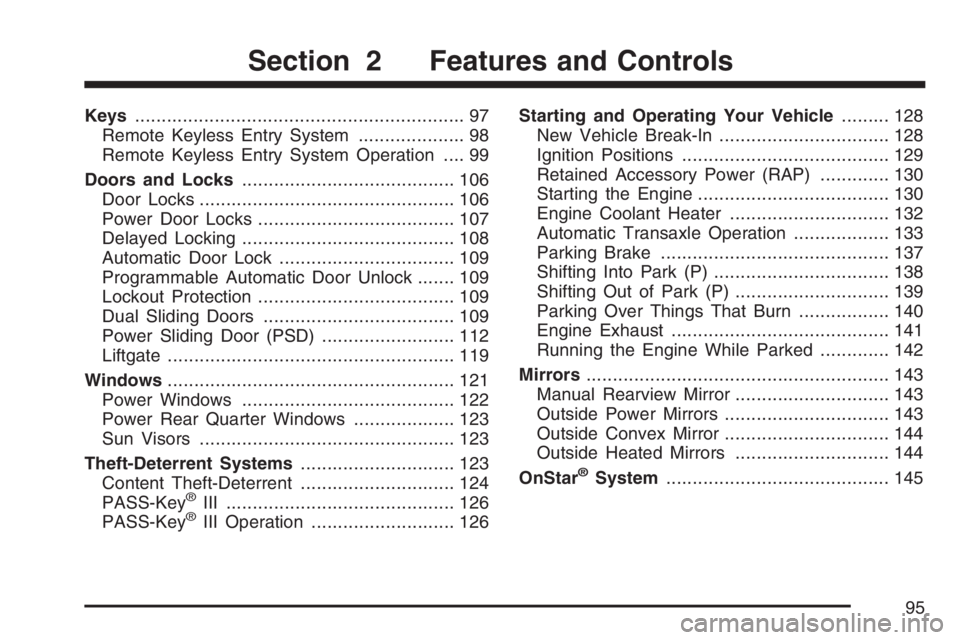
Keys.............................................................. 97
Remote Keyless Entry System.................... 98
Remote Keyless Entry System Operation.... 99
Doors and Locks........................................ 106
Door Locks................................................ 106
Power Door Locks..................................... 107
Delayed Locking........................................ 108
Automatic Door Lock................................. 109
Programmable Automatic Door Unlock....... 109
Lockout Protection..................................... 109
Dual Sliding Doors.................................... 109
Power Sliding Door (PSD)......................... 112
Liftgate...................................................... 119
Windows...................................................... 121
Power Windows........................................ 122
Power Rear Quarter Windows................... 123
Sun Visors................................................ 123
Theft-Deterrent Systems............................. 123
Content Theft-Deterrent............................. 124
PASS-Key
®III ........................................... 126
PASS-Key®III Operation........................... 126Starting and Operating Your Vehicle......... 128
New Vehicle Break-In................................ 128
Ignition Positions....................................... 129
Retained Accessory Power (RAP)............. 130
Starting the Engine.................................... 130
Engine Coolant Heater.............................. 132
Automatic Transaxle Operation.................. 133
Parking Brake........................................... 137
Shifting Into Park (P) ................................. 138
Shifting Out of Park (P)............................. 139
Parking Over Things That Burn................. 140
Engine Exhaust......................................... 141
Running the Engine While Parked............. 142
Mirrors......................................................... 143
Manual Rearview Mirror............................. 143
Outside Power Mirrors............................... 143
Outside Convex Mirror............................... 144
Outside Heated Mirrors............................. 144
OnStar
®System.......................................... 145
Section 2 Features and Controls
95
Page 96 of 562
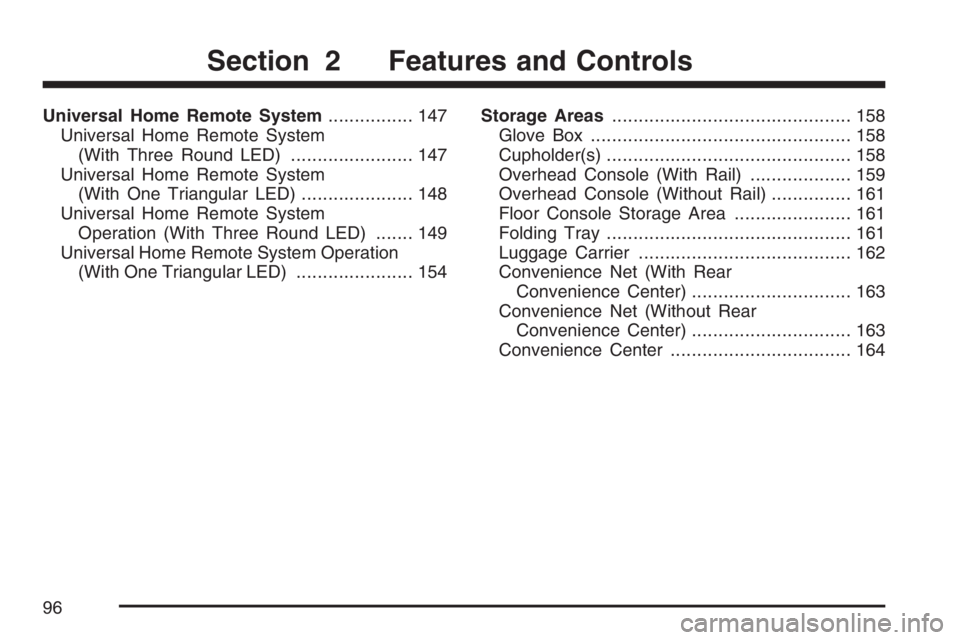
Universal Home Remote System................ 147
Universal Home Remote System
(With Three Round LED)....................... 147
Universal Home Remote System
(With One Triangular LED)..................... 148
Universal Home Remote System
Operation (With Three Round LED)....... 149
Universal Home Remote System Operation
(With One Triangular LED)...................... 154Storage Areas............................................. 158
Glove Box................................................. 158
Cupholder(s).............................................. 158
Overhead Console (With Rail)................... 159
Overhead Console (Without Rail)............... 161
Floor Console Storage Area...................... 161
Folding Tray.............................................. 161
Luggage Carrier........................................ 162
Convenience Net (With Rear
Convenience Center).............................. 163
Convenience Net (Without Rear
Convenience Center).............................. 163
Convenience Center.................................. 164
Section 2 Features and Controls
96
Page 97 of 562
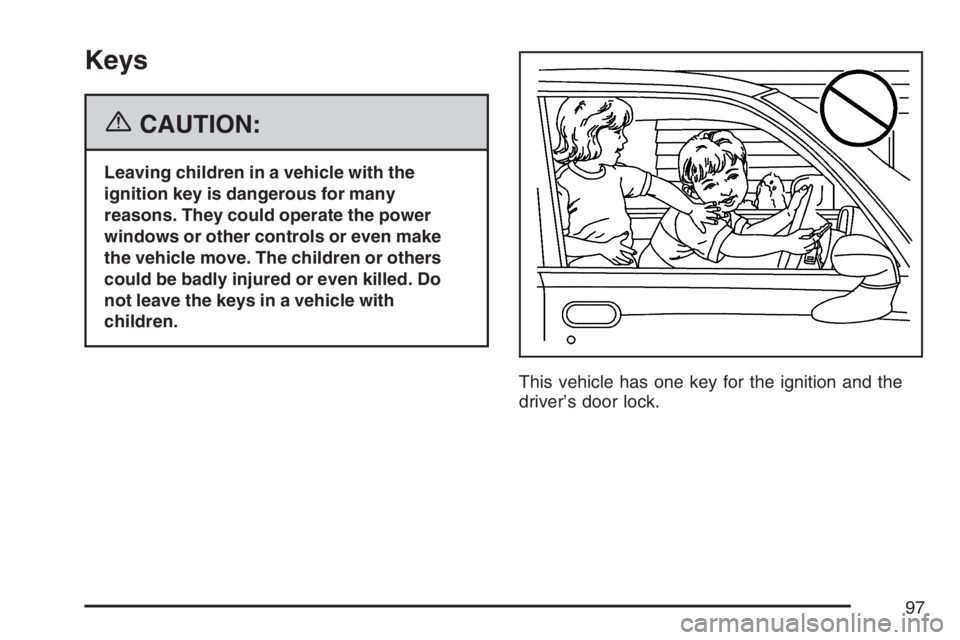
Keys
{CAUTION:
Leaving children in a vehicle with the
ignition key is dangerous for many
reasons. They could operate the power
windows or other controls or even make
the vehicle move. The children or others
could be badly injured or even killed. Do
not leave the keys in a vehicle with
children.
This vehicle has one key for the ignition and the
driver’s door lock.
97
Page 98 of 562
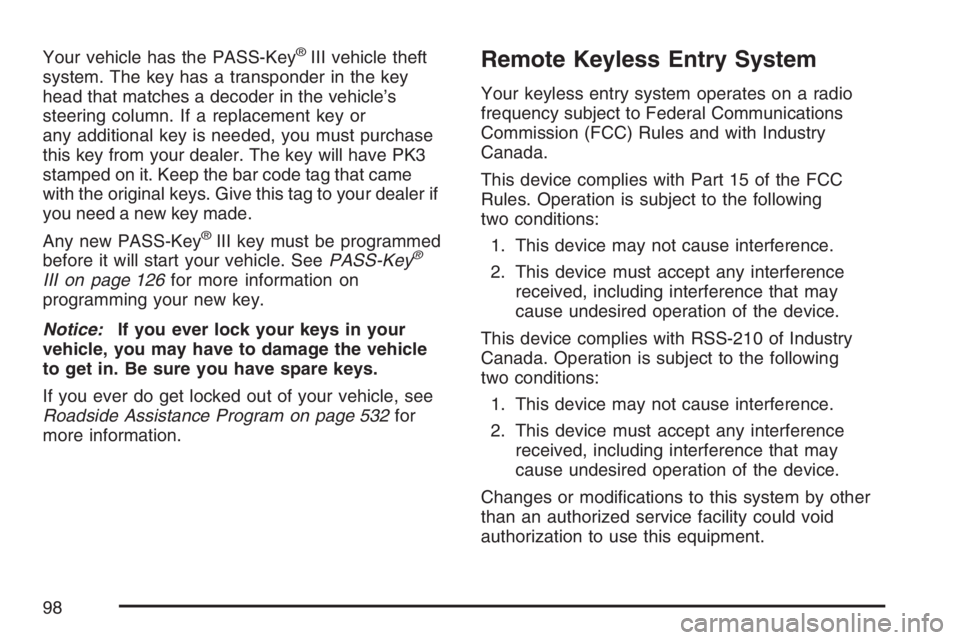
Your vehicle has the PASS-Key®III vehicle theft
system. The key has a transponder in the key
head that matches a decoder in the vehicle’s
steering column. If a replacement key or
any additional key is needed, you must purchase
this key from your dealer. The key will have PK3
stamped on it. Keep the bar code tag that came
with the original keys. Give this tag to your dealer if
you need a new key made.
Any new PASS-Key
®III key must be programmed
before it will start your vehicle. SeePASS-Key®
III on page 126for more information on
programming your new key.
Notice:If you ever lock your keys in your
vehicle, you may have to damage the vehicle
to get in. Be sure you have spare keys.
If you ever do get locked out of your vehicle, see
Roadside Assistance Program on page 532for
more information.
Remote Keyless Entry System
Your keyless entry system operates on a radio
frequency subject to Federal Communications
Commission (FCC) Rules and with Industry
Canada.
This device complies with Part 15 of the FCC
Rules. Operation is subject to the following
two conditions:
1. This device may not cause interference.
2. This device must accept any interference
received, including interference that may
cause undesired operation of the device.
This device complies with RSS-210 of Industry
Canada. Operation is subject to the following
two conditions:
1. This device may not cause interference.
2. This device must accept any interference
received, including interference that may
cause undesired operation of the device.
Changes or modi�cations to this system by other
than an authorized service facility could void
authorization to use this equipment.
98
Page 99 of 562
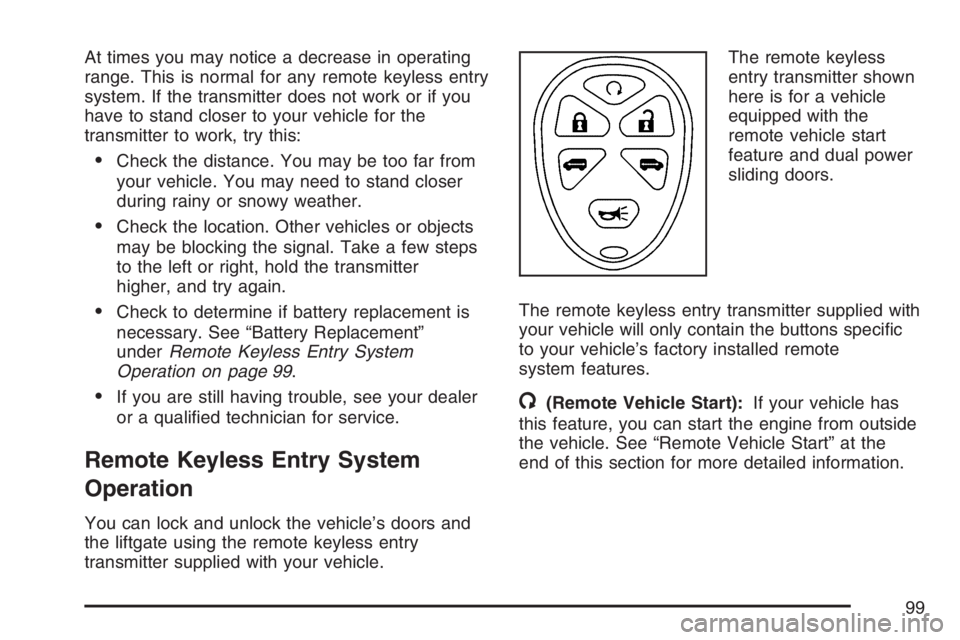
At times you may notice a decrease in operating
range. This is normal for any remote keyless entry
system. If the transmitter does not work or if you
have to stand closer to your vehicle for the
transmitter to work, try this:
Check the distance. You may be too far from
your vehicle. You may need to stand closer
during rainy or snowy weather.
Check the location. Other vehicles or objects
may be blocking the signal. Take a few steps
to the left or right, hold the transmitter
higher, and try again.
Check to determine if battery replacement is
necessary. See “Battery Replacement”
underRemote Keyless Entry System
Operation on page 99.
If you are still having trouble, see your dealer
or a quali�ed technician for service.
Remote Keyless Entry System
Operation
You can lock and unlock the vehicle’s doors and
the liftgate using the remote keyless entry
transmitter supplied with your vehicle.The remote keyless
entry transmitter shown
here is for a vehicle
equipped with the
remote vehicle start
feature and dual power
sliding doors.
The remote keyless entry transmitter supplied with
your vehicle will only contain the buttons speci�c
to your vehicle’s factory installed remote
system features.
/(Remote Vehicle Start):If your vehicle has
this feature, you can start the engine from outside
the vehicle. See “Remote Vehicle Start” at the
end of this section for more detailed information.
99
Page 100 of 562
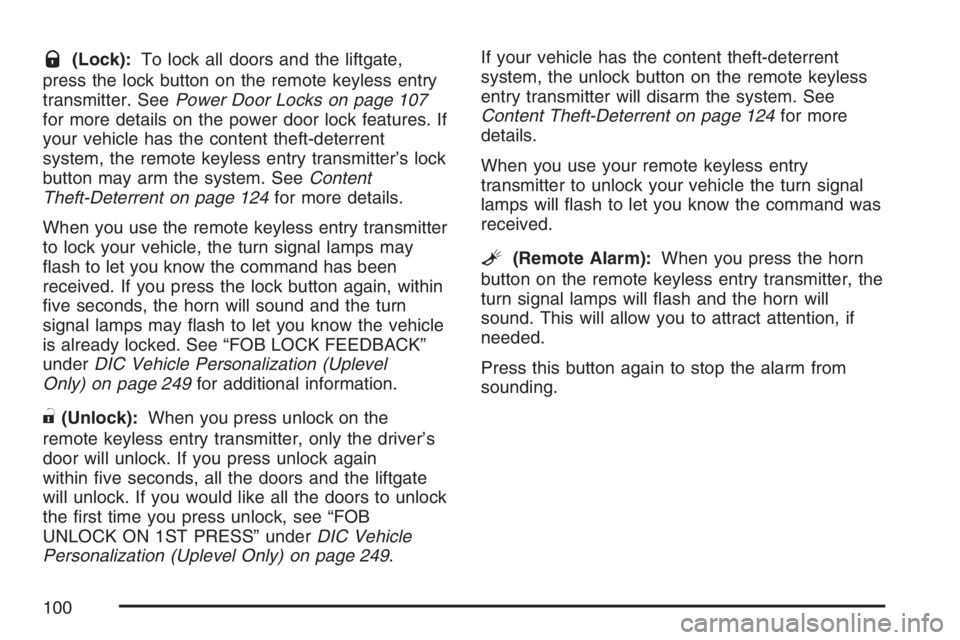
Q(Lock):To lock all doors and the liftgate,
press the lock button on the remote keyless entry
transmitter. SeePower Door Locks on page 107
for more details on the power door lock features. If
your vehicle has the content theft-deterrent
system, the remote keyless entry transmitter’s lock
button may arm the system. SeeContent
Theft-Deterrent on page 124for more details.
When you use the remote keyless entry transmitter
to lock your vehicle, the turn signal lamps may
�ash to let you know the command has been
received. If you press the lock button again, within
�ve seconds, the horn will sound and the turn
signal lamps may �ash to let you know the vehicle
is already locked. See “FOB LOCK FEEDBACK”
underDIC Vehicle Personalization (Uplevel
Only) on page 249for additional information.
"(Unlock):When you press unlock on the
remote keyless entry transmitter, only the driver’s
door will unlock. If you press unlock again
within �ve seconds, all the doors and the liftgate
will unlock. If you would like all the doors to unlock
the �rst time you press unlock, see “FOB
UNLOCK ON 1ST PRESS” underDIC Vehicle
Personalization (Uplevel Only) on page 249.If your vehicle has the content theft-deterrent
system, the unlock button on the remote keyless
entry transmitter will disarm the system. See
Content Theft-Deterrent on page 124for more
details.
When you use your remote keyless entry
transmitter to unlock your vehicle the turn signal
lamps will �ash to let you know the command was
received.
L(Remote Alarm):When you press the horn
button on the remote keyless entry transmitter, the
turn signal lamps will �ash and the horn will
sound. This will allow you to attract attention, if
needed.
Press this button again to stop the alarm from
sounding.
100